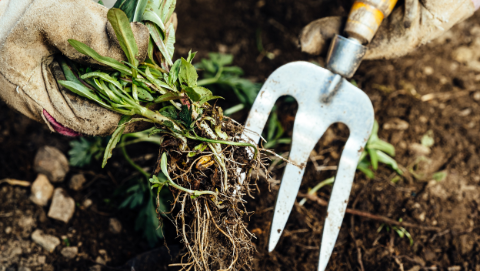Prevent Injury in the Garden with Proper Posture, Tool Use, and Stretches
By: Gabriela Murza, Professional Practice Extension Assistant Professor, Health and Wellness/HEART Initiative

Think back to the last time you worked in the garden. What activities did you do? How long did you work? How did you feel right after (in addition to feeling a huge sense of accomplishment for a great day’s work)?
Now here’s the big question: How did you feel the next day?
No matter if you’re a weekend gardener or do it as part of your job, you probably had those experiences where you may have worked a little too hard for a little too long, and then felt sore or pain for a few days. While soreness typically stems from working a new or weak muscle (and goes away within a few days), pain occurs from overworking or doing something incorrectly. The pain can also linger for more than a few days and may signal an underlying issue. These types of injuries can be traumatic, such as a rotator cuff injury, or a Repetitive Strain Injury (RSI), such as back pain.
This article will address RSIs, which occurs to muscles, tendons, and nerves in such areas as the hands, wrists, shoulders, knees, and lower back caused by doing the same movement for an extended period of time. This can lead to tenderness, pain, or weakness in the affected area. There are many treatment methods, but we are going to discuss ways to help prevent RSIs or at least lessen the recovery time if we experience them!
There are three ways you can minimize pain and prevent RSIs while gardening:
Adapt the Garden:
Create designs that promote healthy posture, movement, and maintenance. Examples include using raised beds and vertical gardens to avoid hunching over and kneeling; and appropriate placement of gardening elements, such as stepping stones and lightweight pottery that can be worked around without twisting, over-reaching, or pulling.
Adapt the Tools:
Use tools that are appropriate for the job and built for your needs and abilities. Examples include tools with ergonomic handles and attachments for gripping comfortably and keeping the wrist straight, and rakes and shovels with height-appropriate handles that help you maintain a straight back and avoid hunching over.
Adapt Yourself:
Assess your abilities, prepare properly, and utilize safe movements.
- Wear comfortable, breathable clothing and closed-toed shoes with ankle support. Even if it’s cloudy outside, put on sunscreen, a hat, and sunglasses if needed.
- Keep your tools and other essentials (trash bags, water bottle, cell phone, snacks, etc.) with you in a bucket or cart that travels with you while you work around the garden.
- Carry water with you and drink often. It’s best to drink water before gardening so you don’t start off dehydrated. Drink every 15-20 minutes while gardening, and drink water afterwards to help replace what you may have lost through sweat.
- Schedule tasks for cooler times of the day and break them into shorter activities. Try to avoid gardening for more than 1.5 hours at a time and incorporate the outlined suggestions.
- Change tasks every 20 minutes to something that utilizes alternate muscles and intensities (e.g., change to an activity that requires standing after kneeling). Or take a break altogether, stretch the muscles you used, and hydrate.
- Engage your leg muscles rather than your arms and back when lifting, carrying, and putting down items, changing directions, and moving back and forth (e.g., raking and shoveling).
- When working low to the ground, kneel rather than crouch or squat. Use a foam mat or knee pads to cushion your knees. Kneel on one knee while keeping the other foot on the ground for support. This helps avoid hunching while keeping your back straight. Alternate every couple of minutes.
- Stretch before, during, and after gardening. Gardening is considered a physical activity, so treat it the same way as any form of exercise. Warm up your muscles first before stretching. As you take breaks, stretch the used muscles. At the end, do whole-body stretches.
References
Centers for Disease Control and Prevention (2017). Heat Stress: Hydration. https://www.cdc.gov/niosh/mining/UserFiles/works/pdfs/2017-126.pdf
Cleveland Clinic (2022). Repetitive Strain Injury. Health Library. https://my.clevelandclinic.org/health/diseases/17424-repetitive-strain-injury
Chiropractic Ontario (n.d.). Gardeners are athletes too! Talking Back Newsletter. Issue 4. https://d2oovpv43hgkeu.cloudfront.net/_att/a1872347-3a42-4236-8fcd-3e4634b393ef/talkingback_newsletter_2007_spring.pdf
Green Thumbs, Healthy Joints (2011). Accessible gardening: gardening ergonomics. West Virginia University. http://greenthumbs.cedwvu.org/media/1165/ergonomic.pdf
Kham, K. (2021). How to tell the difference between soreness and an injury. UTHealth Houston. https://www.utphysicians.com/how-to-tell-the-difference-between-soreness-and-an-injury/
Park, S. & Shoemaker, C. (2009). Observing body positions of older adults while gardening for health benefits and risks. Activities, Adaptation & Aging, 33(1), 31-38. https://www.tandfonline.com/doi/abs/10.1080/01924780902718582
Rebound Orthopedics and Neurosurgery (n.d.). How to know the difference between soreness and pain. News and Events. https://www.reboundmd.com/news/how-know-difference-between-soreness-and-pain
U.S. Bureau of Labor Statistics (2021). Occupation snapshot: Landscaping and groundskeeping workers, 2015-2019. https://www.bls.gov/iif/oshwc/case/osn-landscaping-and-groundskeeping-workers-2015-19.htm

